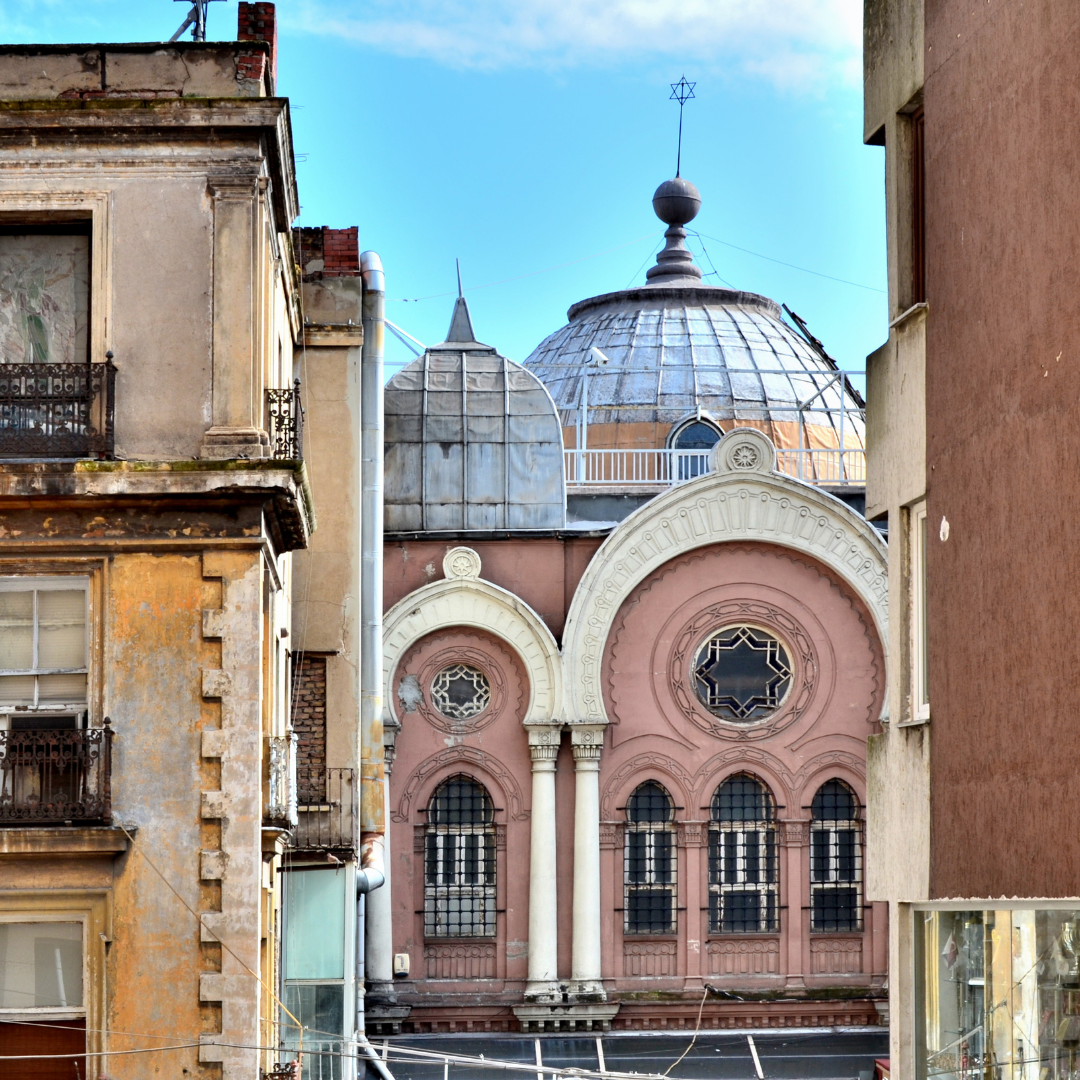Ashkenazi Synagogue Of Istanbul:
The Ashkenazi Synagogue is located near the Galata Tower in the Beyoğlu district of Istanbul. Stands in the middle of the large street connecting to the lower section of the Galata neighborhood. This area is the former banking financial section of the city. The building was designed by architect Gabriele Tedeschi. The beautiful façade is composed of three richly decorated grand arcades crowned by two domes.it recalls the facades of numerous synagogues built in the nineteenth century in cities of the Austro-Hungarian Empire by bourgeois Jews. And it is not by accident, since many of Istanbul’s Ashkenazim arrived here from Austria and Hungary. The plaque at the entrance to the synagogue commemorates among other things, the fiftieth birthday of Emperor Franz Joseph, whose wife game to the synagogue the magnificent Aron made of carved alder and inlay and crowned by a wooden dome decorated with gold. It is in fact the only currently active Ashkenazi Synagogue in Istanbul that is open to visits and prayers. Founded by Jews of Austrian origin in the 20th century. With a dome painted to resemble shining stars and its chandeliers which brought from Vienna, the Synagogue borrows a number of influences from Islamic motifs and its unique architecture evokes a typical Ottoman summer palace.
The Synagogue continues to preserve Ashkenazi traditions. Out of a total of three synagogues built by Ashkenazim, it is the last remaining synagogue, as the population of Ashkenazi Jews are about 4 percent of the total Jewish population in Turkey. Approximately 2000 Ashkenazic Jews live in Istanbul today.
If you want to visit the Synagogue during weekdays, it is possible in the mornings and for Shabbat services on Saturday mornings. The Synagogue also holds wedding, Bar Mitzvahs and other ceremonies in the Ashkenazi tradition.
Italian Synagogue:

The Italian Synagogue, also known as Kal de los Frankos, This elegant 19th century synagogue resembles a church because of its neo-Gothic style, the Italian Synagogue is discreetly located in a harmonious building behind the wall of a small courtyard the design preserves the original structure dating from 1887.the centuries old presence of Italian Jews in the Ottoman capital is attested by the memory of the ancient Synagogues of Puglia and Messina, which have since disappeared in 1866. The Italian Jews separated from the rest of the Jewish community in Istanbul, which they are judged to be too traditionalist. It is used by Istanbul’s Italian Jewish community during the 19th century, it derivate the name ever since and it is still used. Supported by the Italian embassy they obtained the right from Sultan Abdulaziz to form an autonomous congregation, similar to what already exited for the Ashkenazic community and the Karaites. The façade of the synagogue is restrained but harmonious with its rectangular pediment and brick double staircase leading the entrance of the synagogue. The prayer hall is painted completely white and surrounded by the women’s gallery on the second floor. In 1931 the original building was demolished and a new Synagogue was built in its place. Actually if you want to visit the synagogue you must obtain permission in advance from Turkey’s Chief Rabbinate. Today the Italian community numbers only a few hundred faithful.
The Neve Shalom Synagogue:
It is located on a small street near the Galata Tower. It was built by Genoese in the fourteenth century in a lively quarter that is still at the center of Jewish life in Istanbul. Close to the synagogue you will notice many typical Jewish homes of the period decorated with a Star of David on the pediment. The houses at 5 and 7 Timarci Street have their date of construction engraved on a foundation stone calculated according to both the Hebrew and European calendars. A few of the last surviving grand homes typical of the Ladino way of life remain in this quarter. The Neve Shalom Synagogue was designed by the architects Elio Ventura and Bernard Motola and was built in 1951 on the site of small prayer hall.
The early Ottoman Era consisted of a wide variations of Jewish Communities in Istanbul. After Sultan Mehmet II conquered Istanbul. He encouraged immigration to repopulate the city. Most of the immigrants settled near Galata district.
 English
English  Indonesian
Indonesian  Urdu
Urdu  Taiwanese
Taiwanese  Russian
Russian  Romanian
Romanian  Portuguese
Portuguese  Persian
Persian  Macedonian
Macedonian  Korean
Korean  Japanese
Japanese  Italian
Italian  Indian
Indian  Hungarian
Hungarian  Greek
Greek  German
German  Croatian
Croatian  Chinese
Chinese  Bulgarian
Bulgarian  Arabic
Arabic  French
French  Spanish
Spanish 




